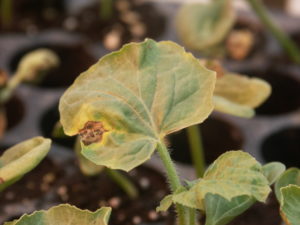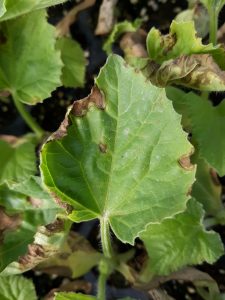In the last issue of the Vegetable Crops Hotline, I wrote an article about common diseases of cantaloupe and watermelon transplants. Based on the samples I have received over the last few days, I would like to write about a disease that is not usually a problem: angular leaf spot.
Angular leaf spot affects all cucurbits. In this article, I would like to concentrate on angular leaf spot on cantaloupe and watermelon. Symptoms of angular leaf spot on cantaloupe often consist of brown, necrotic lesions on the margin of true leaves and seed leaves (Figure 1). On watermelon leaves the lesions may appear darker (Figure 2). Under cool, wet conditions, the disease can be quite severe, resulting in hotspots where seedlings are rendered useless for field transplanting.

Figure 2. Angular leaf spot of watermelon lesions may appear darker than the same disease on cantaloupe.
Angular leaf spot may be seed borne. I suspect that the pathogen may also survive on transplant trays and on greenhouse surfaces. Therefore, sanitation is also part of the answer to management.
In the last few days, I have received flats of transplants with severe angular leaf spot on cantaloupe. My experience is, however, that once in the field, angular leaf spot rapidly disappears with the onset of warmer and drier conditions. I have never known angular leaf spot to cause economically important damage in a field setting on cantaloupe or watermelon.
Years ago, when many growers grew transplants in cool frames, I used to see more angular leaf spot. With the use of heated greenhouses to produce transplants, I have seen less of this disease. I believe that the relatively cool, cloudy spring has caused an uptick in the occurrence of this disease.
Although I don’t expect that angular leaf spot is an important disease of cantaloupe and watermelon, it is important to have the disease officially diagnosed so that it can be confirmed as angular leaf spot and not bacterial fruit blotch.
Growers who are concerned about the spread of angular leaf spot in the transplant greenhouse can apply copper products as labeled. Many copper products are labeled both for cucurbits and greenhouse use. There is a 48-hour reentry period for many copper products which may be reduced to 24 hours if the instructions on the label are followed.
Angular leaf spot may also occur on cucumbers. I have no direct experience with this disease on cucumbers, but the lesions are jagged which may be why the disease is known as angular leaf spot. I have also found angular leaf spot on pumpkin: the lesions on this host may also be angular. Since the disease is favored by cool weather, it is not much of a factor for pumpkin production.
